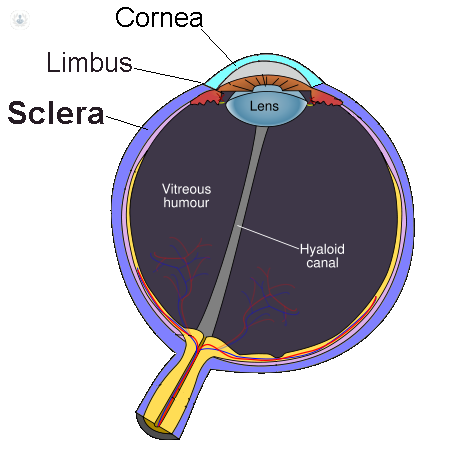Scleritis
Dr Gabriella De Salvo - Ophthalmology
Created on: 11-22-2018
Updated on: 05-16-2023
Edited by: Aoife Maguire
What is scleritis?
Scleritis means that the white layer of tissue in your eye (the sclera) has become inflamed. The sclera protects the rest of the eye and extends from the front to the back of the eye.
There are two main types of scleritis:
- Anterior scleritis – where the sclera is inflamed at the front of the eye.
- Posterior scleritis – where the sclera is inflamed at the back, where the retina and optic nerve are found.
Scleritis is a rare condition, affecting only around 4 people per 100,000 per year in the UK. It can vary in severity from a mild, annoying condition, to a sight threatening disease that needs urgent treatment.
What are the symptoms?
Scleritis is usually a painful condition and classically causes a "deep boring or aching" pain. The eye may be red all over, or just in a specific area. In the case of posterior scleritis, the eye may be white because the inflammation is behind the eye. This usually requires a B scan ultrasound to help make the diagnosis.
Left untreated, scleritis can lead to:
- Pain
- Macular oedema
- Scleral melting
How is it diagnosed?
Scleritis is diagnosed by an ophthalmologist using a microscope to examine the eye. If required, a B scan ultrasound will be requested.
Further testing may be undertaken to look for the underlying cause of scleritis. Occasionally, you may be referred to a rheumatologist.
What causes scleritis?
Scleritis is an inflammatory condition which is often associated with other conditions such as:
In rarer cases, scleritis may be the result of an infection caused by viruses, bacteria or fungi, or even the result of trauma to the eye. Sometimes the cause of the condition is unclear.
How is it treated?
Scleritis is treated depending on the type of scleritis you have.
Mild-moderate scleritis will be managed with eye drops in the first instance. If pain is very bad or there are secondary effects on the internal structures of the eye, first line treatment may be with systemic steroids.
If scleritis keeps coming back, then patients are maintained on medications that are not steroid based.




